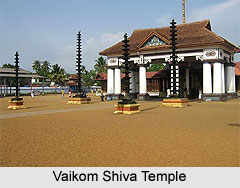 Vaikom Shiva Temple is located in Kottayam district of the southern state of India, Kerala. It is one of the main pilgrim centres of the south. The temple is famous for the Vaikkath Astami celebrations in the months of November-December. It is one of the few temples which is held in reverence by both Shaivites and the Vaishnavites. Vaikkom`s Shiva is fondly called Vaikkathappan. The Shiva Linga here is believed to be from the `Treta Yuga.` Vaikom Shiva Temple is famous for its benign deity. Life in the little town of Vaikom literally revolves round the deity. It is endearingly called Lord of Vaikom or Perumthrikovilappan or simply Vai-katnappan.
Vaikom Shiva Temple is located in Kottayam district of the southern state of India, Kerala. It is one of the main pilgrim centres of the south. The temple is famous for the Vaikkath Astami celebrations in the months of November-December. It is one of the few temples which is held in reverence by both Shaivites and the Vaishnavites. Vaikkom`s Shiva is fondly called Vaikkathappan. The Shiva Linga here is believed to be from the `Treta Yuga.` Vaikom Shiva Temple is famous for its benign deity. Life in the little town of Vaikom literally revolves round the deity. It is endearingly called Lord of Vaikom or Perumthrikovilappan or simply Vai-katnappan.
Vaikom Shiva Temple is one of the biggest temples in Kerala. It has a courtyard of about eight acres of land. The temple premise is protected by compound walls with four Gopuras or towers on all the four sides. The temple faces the East direction. There is a protected platform located near the east Gopura. The great Shaivopasak Vyaghrapada Maharshi is said to have done penance and pooja here. It is here that he got Shiva Shakti Darsana.
A golden flag staff can be seen in the temple complex. A Stambha Ganesha seated at its north east corner can be seen while entering the place of the sacrificial stone. From here one can enter the Namaskara Mandapa. The story of Ramayana is sculptured on the inner roof. A huge Nandi made of a single stone can be seen seated in the east side of this Mandapa. The main inner yard or the Sreekovil of the Vaikom Shiva Temple is round in shape and roofed with copper sheets and with two chambers. The Mukha Mandapa is built in shaped stone and single piece woods. The walls and pillars are very strong.
The garbhagriha or the sanctum santorum is the second chamber built of stone. A platform of about three foot high has been built in the middle of it on which the holy Shiva Linga of Shree Vaikkathappan is consecrated. It is of about six feet high made of chaste black stone. The Linga is adorned with Chandrakala (crescent), three eyes, nose and four hands with Shaiva abharanams (ornaments) in the form of `anky` in pure gold. Inside, the Holy of Holies Oil and ghee lamps are lighted together with camphor. The thousands of devotees who gather here attain fulfilment at the sight of this Holiest Linga reciting all kinds of Sivasthuthis. The outer walls of Sreekovil are decorated nicely with paintings of puranic stories and wooden sculptures.
Apart from the main deity the idol of Vighneswara or Lord Ganesha is located in the Agni cone i.e. south-east corner. It has been established on a Peedhom of stone. There are two idols, Maha Ganapathy in the South and Sakthi Ganapathy in the north. The idols are in pancha loha.
The Mathrusila where the Beli stones of the seven divine Mathas are kept is to the south of Sreekovil. The Nivedya is prepared in the Thidapally which is located in the eastern part of the Mathrusala. The buildings of the temple courts are built surrounding the Sreekovil. One can see the centuries old Vilwa tree in the vayu kone of the Sreekovil. The Ashtadikpalakas or Lords of the eight directions etc. are consecrated in the yard of the Sreekovil. Lord Varuna i.e. the Lord of water finds a special place in the west.
In the temple court of north one can see a very holy place called the `Manya Sthana.` Here Vaikkathappan was seen eating Prathal dressed like a Brahmin, by Vilwamangalathu Swamiyar. A stone has been placed with Ashta dala in his memory. A sloka has also been written on it. A lighted Bhadradeepa is kept in this place and the beginning of Prathal or Annadana is still done from here.





















